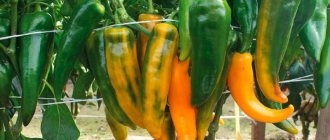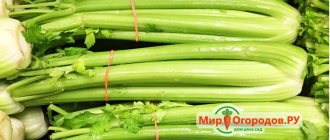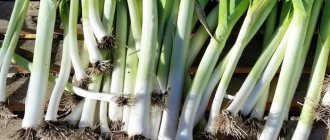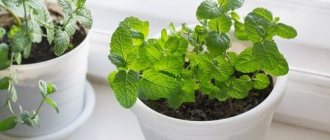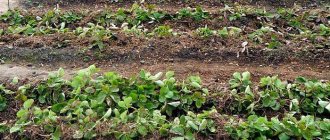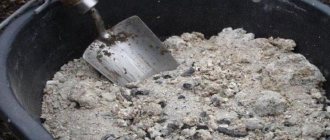A crop such as celery is of great value, since the plant is a real storehouse of vitamins and microelements. But you are here and now not for a lecture about the beneficial properties of this root vegetable, but want to know when to harvest and how to properly store it for a long time.
Well, let's talk about this!
Important! In this material we will mainly talk about the timing of collection and methods of storing celery root. We will also pay a little attention to stalked celery. But there is no point in talking about the leaf variety, because... All greens are prepared and stored the same way.
When to remove root celery from the garden: optimal harvest time
Root celery has one of the longest growing seasons (up to 120-150 days); moreover, it is a short-day plant.
In other words, it is in conditions of decreasing daylight hours and cool autumn weather that celery actively increases its mass and accumulates all its nutrients .
Important! In hot summer weather, celery does not grow!
As for the signs of ripening, it is very simple to visually determine that root celery is ready for harvesting: the root crop will be almost completely on the surface, and only its roots will be in the ground.
In any case, you need to have time to dig up the crop before the onset of stable frosts (small, overnight frosts down to -3..-6, they are not afraid of), otherwise such (frozen) celery will not be stored for a long time.
Thus, the approximate harvest time for root celery in the central zone (Moscow region) is the end of September - the first half of October (as a rule, they are dug up somewhere in early October).
Video: harvesting and storing celery root - timing and methods
Ripening dates in different regions of Russia
The timing of ripening and harvesting of root crops largely depends on the weather conditions of areas located in different climatic zones of Russia, and the varietal characteristics of the crop. It is important to plant a plant that will have time to ripen, and the harvest will be stored for a long time.
When to harvest celery in different regions of Russia:
- The Moscow region is characterized by clearly defined seasonality, high humidity, warm summers, moderately cold winters with stable snow cover and thaw. For these places, mid-early varieties of the crop are chosen, the ripening period of which is 140–150 days. Harvest occurs at the beginning of October.
- The Volga region is characterized by frosts in early spring and late autumn, snowy winters and hot summers, so it is better to plant early and medium varieties here. The harvesting period for celery in this region is September – October.
- For northern regions (Urals and Siberia) with a cold climate and frosty winters, early varieties are chosen for planting, and the harvest is harvested before mid-September.
- In the Krasnodar and Stavropol territories, where the southern climate is warm, varieties of late ripening (about 200 days) are grown. Root crops are dug up at the end of October.
How to properly remove (dig up) root celery from the garden bed and prepare it for storage
You need to dig up root celery as carefully as possible so as not to damage the tubers. To do this, at a distance of 10-15 cm from the tuber, you need to dig it up with a shovel (or use a pitchfork) and remove it (pull it out) from the ground with your hands.
Then you need to prepare the tubers for storage, namely:
- clean (shake) the tubers from the ground;
- wash in water and then dry in the sun for 1-1.5 hours;
- trim the tops, leaving 2-3 centimeter petioles (Do not damage the growing point in any case!);
Young leaves (located in the center of the rosette) of root celery can be used in the same way as leaf celery.
- trim the roots, shortening them to 1.5-2 cm;
By the way! Celery roots can also be used, for example, to prepare vegetable broths.
- let the cut areas dry slightly so that they do not rot, placing them to dry in a shaded room, preferably on a towel;
- store in a basement or cellar, refrigerator or freezer.
Interesting! Some summer residents do not wash celery before storing it and do not even trim the roots.
In principle, the option works if you sprinkle them with sand. In other cases, you will still have to wash and trim the roots.
Winter-hardy root vegetables
Overwintering in the garden, root crops are not deprived of all the beneficial substances they contain. In addition, the plants are unpretentious to grow and are rarely affected by diseases or damaged by pests.
Jerusalem artichoke has so many beneficial properties that the list of them can be endless. Ground pear, as this plant is also called, is a real mix of vitamins, carbohydrates, proteins, organic acids and many other useful substances. Tubers dug up in the fall in the cellar are poorly stored: they become stained and can become moldy. But they overwinter well right in the soil, because the plant is quite cold-resistant. Jerusalem artichoke can overwinter without shelter, but in winters with little snow, it is recommended to cover the beds with straw (5 cm layer) and lay spruce branches on top.
Some vegetable crops are not only useful, but also decorative. For example, Jerusalem artichoke with its tall greenery can cover any unsightly buildings on your site, and its yellow flowers will decorate vegetable beds.
Jerusalem artichoke blooms surprisingly beautifully
Carrots that are not harvested in the fall will safely survive winter frosts if they are well covered. The crop can be kept in an open garden until November, after which it needs to be properly prepared for wintering. First you need to cut off the tops and cover the plantings with spruce paws. A layer of litter and straw up to 15 cm thick should be laid on top of the spruce branches. On top of such a “warm” bed should be covered with film. In cold winters, it is recommended to throw more snow on the carrots so that the root crops do not freeze.
The quality of overwintered carrots decreases significantly by spring. Root crops become overgrown with small roots and dry out a little. Therefore, such carrots are not suitable for fresh consumption; they are more suitable for processing.
Scorzonera is no less cold-resistant . But this plant should also be covered. For this, straw is suitable, which must be laid on the bed in a layer of about 5 cm. If the root crops are not dug up immediately in the spring, the plants will bloom and produce seeds.
parsnips overwinter quite well . But in order to help the plant at least a little, it should be covered with a layer of soil 4-5 cm thick. There should be a small mound in the garden bed. By the way, among all vegetable crops, the plant occupies one of the leading places in terms of the content of easily digestible carbohydrates.
Parsnip root contains calcium, potassium, phosphorus, iron, sodium and folic acid
Daikon and turnips overwinter well in soil . But in order to keep them safe and sound until spring, you will have to make board borders for the garden bed. They should be buried 10-15 cm into the ground on each side of the area with root crops. Before the onset of frost, the tops of daikon and turnips need to be cut off, and the bed should be covered with a layer of 5-10 cm of river sand.
Root vegetables are a real treat for rodents. Especially in winter, when finding food becomes more difficult. And plantings covered with spruce branches can generally become their home for the entire cold period. Therefore, in order to preserve the harvest, it is worth putting poison for pests under the shelter.
How to store celery root: long-term storage methods
Proper storage will provide you with a celery harvest for the entire period until the next harvest.
Thus, root celery can be stored fresh (up to 2-4 months, in the refrigerator - from a week to a month), frozen (up to a year), and even longer dried (it is most convenient to dry in an electric dryer) or canned (salted).
In principle, celery can be stored like carrots (ideally in sand) or beets .
Fresh
The key to long-term storage of any fresh vegetables and fruits is a stable temperature (0..+4) and humidity (80-90%).
As for storage space, it can be either a cellar or basement (if you are the owner of a private house or the owner of a garage), or a refrigerator (if you live in an apartment and have a garden in your country house).
According to most gardeners, the most reliable way to keep root celery fresh in the basement or cellar is to store it in sand . Namely, only the root system is sprinkled with sand; there is no need to fill the tuber itself.
An equally popular storage method is to wrap the tubers in cling film . In this form, you can put the root vegetables in the same refrigerator.
In general, root celery will be stored well in plastic bags with perforations (ventilation holes).
Freezing
If you don’t have a cellar or basement, the refrigerator is full of other products, and you want to preserve celery longer, then the freezer comes to the rescue.
So, to freeze celery for the winter, you need to wash it, dry it, cut it (for example, into strips), place it in freezer bags or containers and put it in the freezer.
Later use it for adding to soups and frying.
Cold Hardy Greens
Not only root vegetables, but also greens, such as parsley, celery root or chard, can be left to overwinter in the ground. In the spring, just a couple of weeks after the snow melts, they will produce their first harvest. I don’t think it’s worth telling how useful early greens are.
a bed with parsley with earth or mulch it with humus (or compost) in a layer of 5-10 cm. However, it is not worth keeping the parsley planting until summer, since the plants of the second year grow powerful flower stalks, and the green mass becomes smaller and coarser.
Parsley of the second season practically does not lose its beneficial properties over the winter.
Celery also tolerates wintering well in soil . Before wintering, it needs to be trimmed (cut off the tops) and covered with soil. It is advisable to cover the bed with spruce branches on top.
The spruce branches retain the snow in the garden bed and thereby protect the plantings from freezing. However, in the spring it is very important to remove this cover in time so that the plants do not dry out.
Chard is another cold-resistant green that overwinters safely in the ground if it is covered with a layer of peat or sawdust (3-5 cm). If neither one nor the other is found on the farm, ordinary dry leaves will do.
Features of harvesting and storing petiole celery
There are no nuances when harvesting and storing stalked celery (compared to root celery), except that you need to remove it only after the process of bleaching the petioles (of course, if you do not have a self-bleaching variety).
In general, even the timing of harvesting petiole celery coincides with the root one, but it is better to harvest the petiole variety before the first frost (it is more tender).
Important! If you do not bleach the petioles, they will be less juicy and there will be a more pronounced bitterness in them.
Advice! Protecting the petioles from sunlight (bleaching) should begin 2-3 weeks before harvesting.
As for the ways to store petiole celery, you can:
- store fresh in the basement or refrigerator (for example, wrapped in foil or paper and a plastic bag);
Storage idea! First you need to dry the petioles on a towel (to get rid of droplets of moisture), and then fill the jar , close it tightly with a lid and put it in a dark and cool place (refrigerator or cellar).
The author of the next video suggests storing petiole celery in sand (moist) in the same way as root celery.
Video: how to preserve petiole celery
- cut and freeze .
- Of course, petioles, like roots and leaves, can also be dried .
- But it’s better if you canned or salted (there are dozens of recipes).
As for use, fresh stalked celery is primarily suitable for preparing salads and juice, while frozen stalks can be added to first and second courses (including fried ones), and dry stalks can be used as an aromatic addition to dishes.
Video: harvesting and storing petiole celery
Harvest crowd
A gardener will grow large, sweet stalks of celery unless he follows all the rules when planting. It is necessary to find out what harvest dates this crop has.
Celery is painfully sensitive to negative temperatures. This is especially true for self-bleaching varieties, as they are not buried in the soil and not mulched. What can you do to cut them off before the onset of cold weather, no later than September. If you have insulation, you can postpone collection for 2 weeks.
Super valuable!
The recommendations on agricultural technology specify the timing of harvesting, in most cases they are 11-16 weeks. On the other hand, the vegetables will become coarser and lose their taste and aroma.
The entire celery is dug up from the soil, the roots are removed, and in this state they are sent to rest. Ant. spending. For varieties that need growing, do not interrupt the roots, sprinkle them with damp sand and place them in a cellar or greenhouse.
Beneficial features
Crispy petioles and tubers are a rich source of fiber, which is necessary to normalize metabolic processes, reduce blood cholesterol and improve digestion. Additionally, the vegetable provides a surge of strength, a release of energy, and helps withstand intellectual stress.
Celery is also used in the prevention and treatment of many diseases of the body:
Everyone knows that petiole celery is a storehouse of vitamins and other useful substances. It can be grown both in garden beds and on the windowsill. In this article we will look at how to grow petiole celery.
In fact, there are quite a lot of varieties of celery. And there are varieties whose petioles themselves are quite long. They are eaten in the same way as the leaves. But these varieties do not provide that amazing aroma, taste (who of course loves it) and pleasant crunch.


